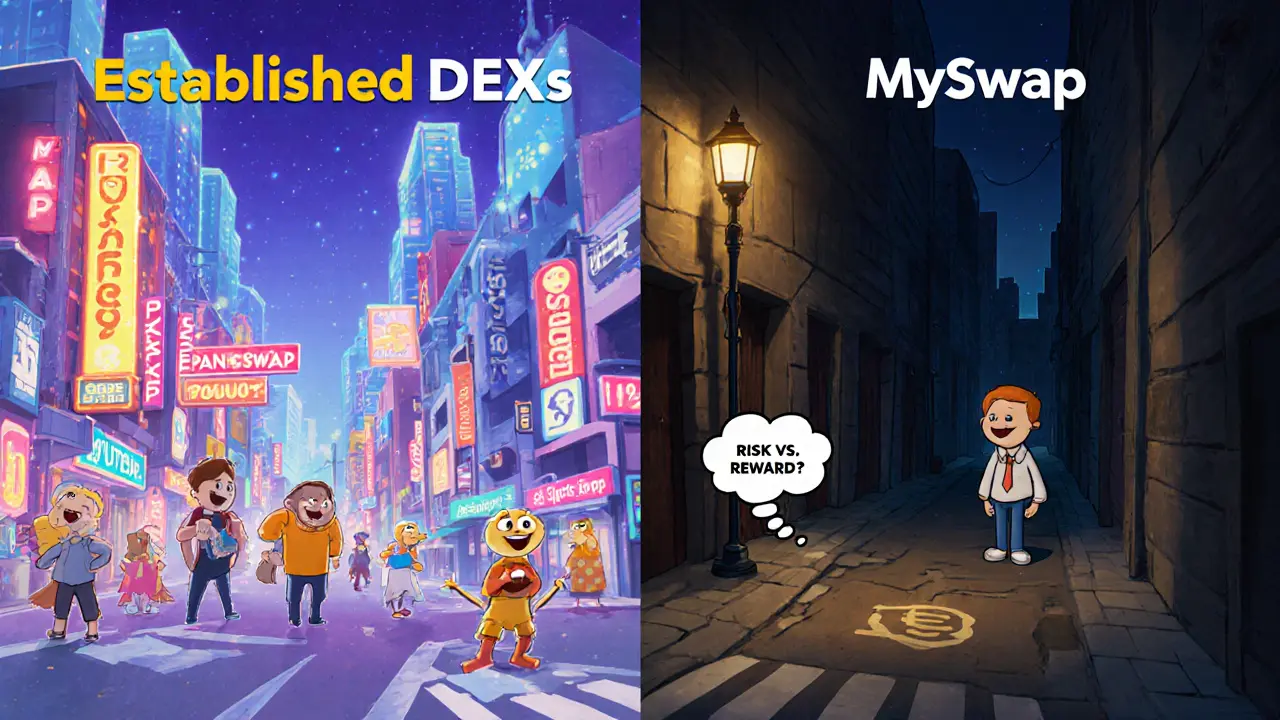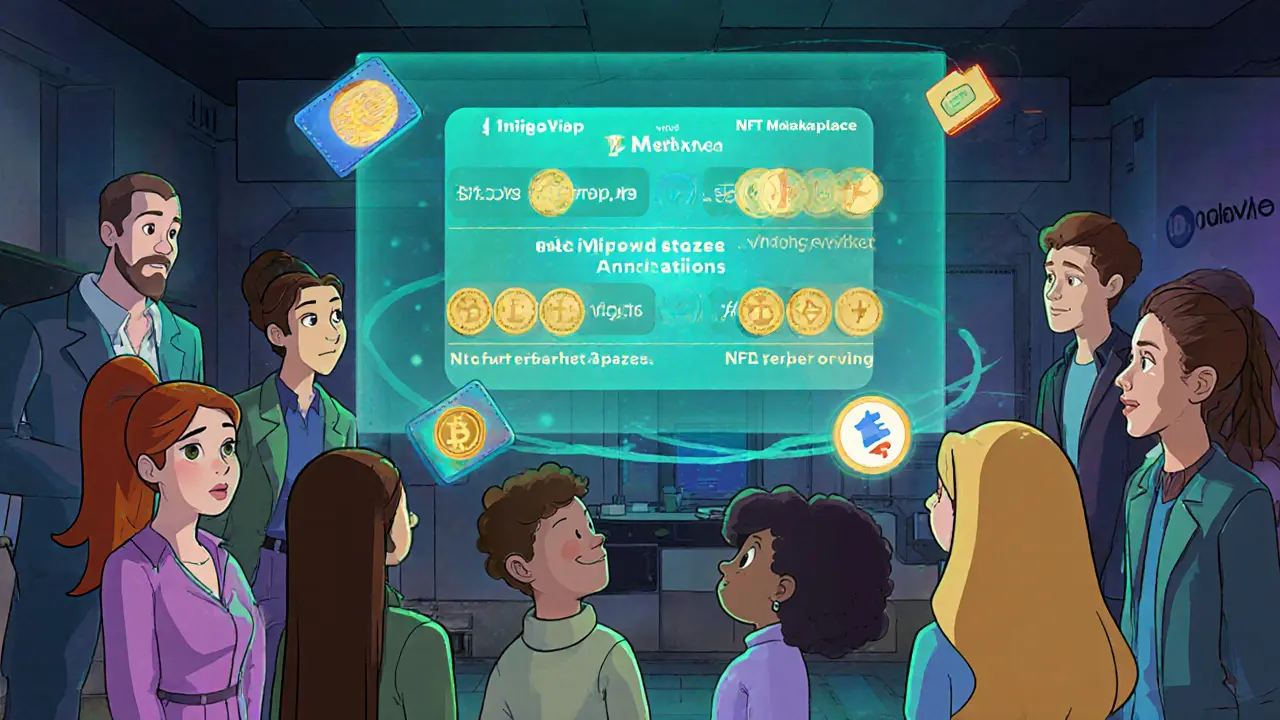MySwap Risk Assessment Calculator
Risk Assessment Results
Liquidity
Low trading volume indicates poor liquidity, leading to high slippage and limited trading opportunities.
Security
Limited audit history and website errors suggest potential security vulnerabilities.
Activity
Low user count and minimal trading activity indicate a lack of community trust.
Key Takeaways
- MySwap operates on OKExChain and combines a DEX, NFT marketplace, and DAO tools, but its trading volume is under $1,000 daily.
- The platform offers free usage, standard AMM swapping, and wide wallet support, yet real‑world liquidity is virtually nonexistent.
- Compared with established DEXs like Uniswap and PancakeSwap, MySwap ranks far behind on volume, user ratings, and ecosystem activity.
- Security appears decent on paper - non‑custodial, smart‑contract based - but the lack of recent audits and the 403 website error raise red flags.
- For casual traders or NFT enthusiasts seeking active markets, MySwap is a high‑risk, low‑reward option; institutional users should look elsewhere.
What Is MySwap?
MySwap is a decentralized finance (DeFi) platform that merges a decentralized exchange (DEX), an NFT marketplace, and DAO governance tools on the OKExChain network. Launched in early 2023, the project promises “free convertibility of high‑quality digital assets” and a “one‑stop liquidity service” for users. Despite these ambitions, major market trackers list MySwap as an “untracked” exchange because daily trading volume never broke the $1,000 mark in 2024.
Core Features and How They Work
MySwap follows the typical Automated Market Maker (AMM) model, meaning users trade against smart contracts rather than order books. Below are the three pillars the platform claims to support:
- DEX Swaps: Instant token swaps on OKExChain, with price slippage calculated by the constant‑product formula (x·y=k).
- NFT Marketplace: A dedicated UI for minting, buying, and selling NFTs, though no significant trading volume is recorded.
- DAO Governance: Token‑based voting on protocol upgrades, fee structures, and liquidity incentives.
All three functions share the same wallet integration layer. The platform lists compatibility with MetaMask, Coinbase Wallet, WalletConnect, Argent, and other popular wallets.

Technical Backbone - OKExChain and Smart Contracts
OKExChain is a public blockchain launched by the OKEx exchange, focusing on high‑throughput, low‑cost transactions for DeFi applications. MySwap’s contracts are deployed on this chain, leveraging its fast block times (≈1s) and modest gas fees (<$0.001 per transaction). However, OKExChain’s total value locked (TVL) fell from $1.2billion in early2022 to roughly $85million by mid2024, according to DeFi Llama data, signaling a shrinking user base.
The AMM contracts used by MySwap appear to be standard Solidity implementations, but public audit reports are absent. Without third‑party verification, the risk of hidden vulnerabilities remains higher than on audited platforms like Uniswap.
Liquidity Landscape - Why Volume Matters
Liquidity is the lifeblood of any DEX. A healthy pool should easily handle large trades with minimal slippage. MySwap’s reported 24‑hour volume stays under $1,000, making it practically unusable for anything beyond tiny test swaps. For comparison, see the table below.
| Exchange | Primary Chain | 24‑h Volume (USD) | User Ratings (Slashdot) | Active Features |
|---|---|---|---|---|
| Uniswap | Ethereum | 1.6B | 4.5/5 (2,300 votes) | DEX, LP incentives, Analytics |
| PancakeSwap | BNB Smart | 420M | 4.2/5 (1,800 votes) | DEX, NFTs, Launchpad |
| SpiritSwap | Fantom | 12M | 3.8/5 (51 votes) | DEX, Yield farming |
| MySwap | OKExChain | <$1,000 | 0 ratings | DEX, NFT, DAO (limited activity) |
Fees, Costs, and Pricing Model
MySwap advertises a “free version” with no explicit trading fees listed on its site-likely because the platform relies on the underlying AMM fee (usually 0.3%) that goes straight to liquidity providers. There is no tiered fee structure, premium subscription, or token‑based rebate system reported.
While zero‑fee marketing sounds attractive, the hidden cost is the opportunity loss from near‑zero liquidity. Traders on larger DEXs can execute multi‑million dollar swaps with sub‑0.1% slippage; on MySwap, even a $100 trade could suffer 5‑10% slippage, eroding any perceived fee advantage.

Security and Audits
The platform is non‑custodial: users retain private keys in external wallets like MetaMask (MetaMask a popular browser extension wallet for Ethereum‑compatible chains). This reduces the risk of exchange hacks but transfers all smart‑contract risk to the protocol.
No public audit reports have been released for MySwap’s contracts, and the Github repository (github.com/myswap-xyz) shows only 12 commits as of May2024 with no activity after early 2023. The official website (www.myswap.xyz) consistently returns a 403 error, which hampers transparency and raises concerns about ongoing maintenance.
User Experience - Onboarding, Interface, and Support
From a UI perspective, MySwap mirrors familiar AMM layouts: a token selection dropdown, price preview, slippage tolerance slider, and “Swap” button. The design is clean, and wallet connection is straightforward through WalletConnect or direct MetaMask injection.
Support claims include “Business Hours” live reps and online documentation, but attempts to contact support through the site’s chat widget in October2025 resulted in an auto‑reply directing users to a dead link. Training resources-webinars, live training, and in‑person sessions-are listed but unverified, making it unclear whether users can actually access them.
Community and Ecosystem Signals
Community activity is a good proxy for health. A search of Reddit, BitcoinTalk, and major review platforms turned up virtually no dedicated threads on MySwap. Slashdot’s comparative analysis (Feb2024) recorded zero user ratings, contrasting sharply with SpiritSwap’s 51 ratings and Uniswap’s thousands.
On Twitter, the only notable mention comes from a March2024 thread by the pseudonymous analyst “ChainSage,” who warned that “OKExChain‑native DEX projects struggle with sustainable liquidity.” No official roadmap updates have been posted since 2023, suggesting the project may be dormant.

Regulatory Outlook
As a non‑custodial DEX, MySwap falls under emerging DeFi regulations rather than traditional exchange licensing. The EU’s MiCA framework, effective in 2025, could impose reporting obligations on projects that facilitate token swaps in the European Economic Area. In the United States, the SEC continues to scrutinize decentralized platforms for possible securities violations. MySwap’s low activity likely keeps it off regulators’ radar for now, but any future expansion beyond OKExChain would trigger compliance checks.
Should You Use MySwap?
Answering this question boils down to risk tolerance and intended use case:
- Casual Swappers: If you just want to experiment with a tiny amount of OKExChain tokens, MySwap can serve as a sandbox, provided you accept the likely high slippage.
- NFT Collectors: The marketplace is technically live, but lack of buyers means you’ll struggle to sell any minted asset.
- Liquidity Providers: Providing capital to a pool with sub‑$1,000 daily volume offers negligible fees and high impermanent loss risk.
- Institutional or Serious Traders: Stick to established DEXs (Uniswap, PancakeSwap) or centralized exchanges with proven liquidity and audits.
Overall, MySwap appears more like a proof‑of‑concept that never gained traction. Until the team publishes audited code, a functional roadmap, and demonstrates real market depth, the platform remains a high‑risk experiment.
Bottom Line
MySwap tries to bundle DEX swapping, NFT trading, and DAO governance into a single OKExChain‑based suite. The idea is solid, but the execution falls short: negligible volume, zero user reviews, no public audits, and a non‑responsive website. For anyone looking to trade or invest in DeFi, the safer bet is to choose platforms with proven liquidity, active communities, and transparent development.
Frequently Asked Questions
Is MySwap a centralized exchange?
No. MySwap is a non‑custodial decentralized exchange (DEX) that runs on smart contracts on OKExChain. Users keep their private keys in external wallets.
What chains does MySwap support?
The core swapping engine is built on OKExChain. The platform claims compatibility with wallets that can connect to other EVM‑compatible chains, but active liquidity exists only on OKExChain.
Are there any fees for using MySwap?
MySwap does not list a separate platform fee. Trades incur the standard AMM fee (around 0.3%) that goes to liquidity providers, plus any network gas costs on OKExChain.
Is MySwap’s smart‑contract code audited?
No public audit reports have been released. The lack of third‑party verification is a red flag for security‑focused users.
Can I trade NFTs on MySwap?
The NFT marketplace component exists, but activity is minimal. You can list NFTs, yet finding buyers is difficult due to low traffic.
Ayanda Ndoni
October 10, 2025 AT 18:26Elliott Algarin
October 11, 2025 AT 16:35John Murphy
October 12, 2025 AT 08:07Patrick De Leon
October 12, 2025 AT 19:18MANGESH NEEL
October 13, 2025 AT 09:02Sean Huang
October 14, 2025 AT 08:27Ali Korkor
October 14, 2025 AT 14:12madhu belavadi
October 15, 2025 AT 06:41Dick Lane
October 15, 2025 AT 10:16Norman Woo
October 15, 2025 AT 21:19Serena Dean
October 16, 2025 AT 10:57James Young
October 16, 2025 AT 21:07Chloe Jobson
October 16, 2025 AT 21:18Andrew Morgan
October 17, 2025 AT 05:11